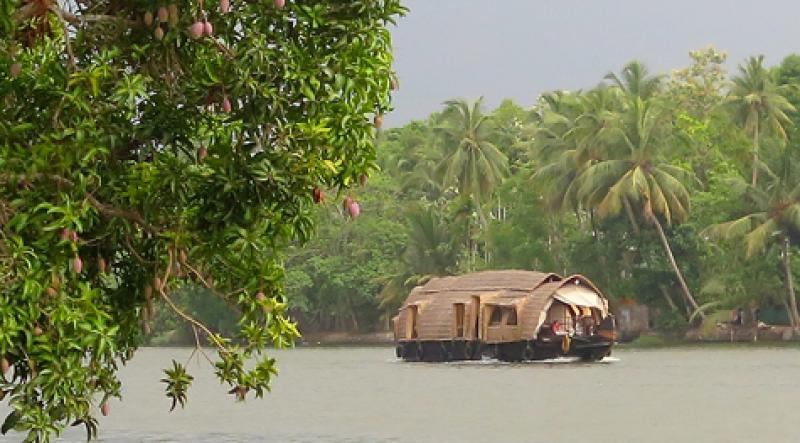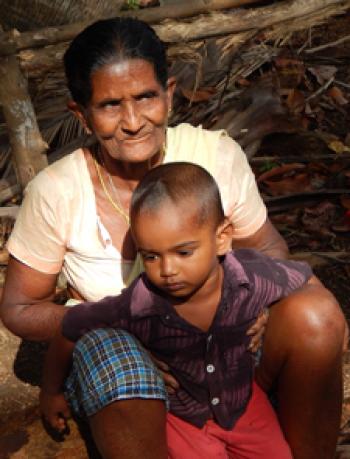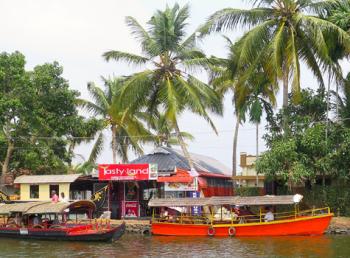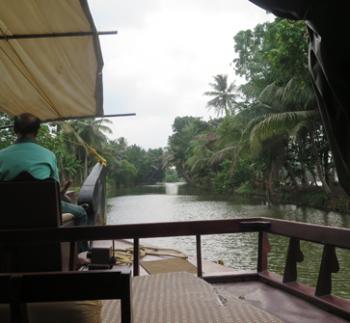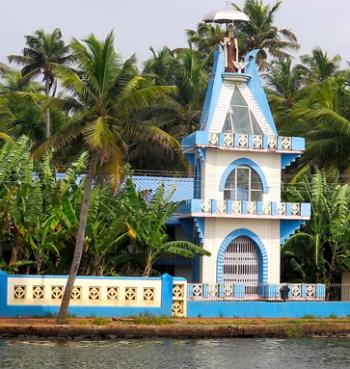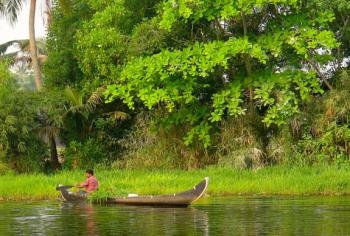Kerala’s narrowest backwaters
When Jean Fischer of Brevard, North Carolina, booked four days and three nights on a houseboat in the Kerala backwaters in southwestern India in April 2016, she expected to visit the types of very narrow canals she had seen when she last visited the region on a day trip in 2012, places where the boat was almost under the trees and locals could be easily observed on the banks at their daily tasks.
On her 2016 cruise-tour, however, though on one afternoon she was taken down canals so narrow that only two small boats could pass each other, she was disappointed that the rest of the cruise was spent on much wider waterways and on the nearby lake (June ’17, pg. 25).
To identify trips that focus more strongly on the waterways that Ms. Fischer had in mind, ITN asked subscribers who had recently visited scenic, very narrow backwater channels in Kerala state to tell us where they went, which company they traveled with (plus contact info), the type of trip they were on (cruise ship’s shore excursion, multiday tour, etc.) and when they were there.
Responses are printed below. Note that while some of the waterways described are more “narrow” than others, all the writers felt that their cruises/tours provided rewarding experiences.
I took a tour of southern India with Overseas Adventure Travel, or OAT (Cambridge, MA; 800/955-1925, www.oattravel.com), Jan. 9-25, 2017. OAT had recently revised their “Soul of India” trip, which I was on, to include two nights in the Kerala backwaters aboard houseboats operated by Spice Hotels around Alleppey.
On the boats, we did see many of the sights of the backwaters, including the people, the tangled hyacinth plants, the local life, a wedding and much more.
During our 2-night stay on the houseboats (which were quite deluxe, I might add), we spent one hour in a dugout canoe, then half a day on a larger vessel that cruised the backwaters and made periodic stops. In both cases, we were able to meet locals.
Parts of the backwaters look like land due to the overgrowth of hyacinth in the water. In fact, the plants can disrupt life because boats cannot go through them and objects can get tangled up in them.
As we were cruising toward the shore, the “buses” (huge water taxis) we saw that were taking women to work in the fields were just remarkable, as were other signs of everyday life along the banks. We could see women washing their clothes in the water. As they pounded them dry, the sounds carried over the water.
I woke up to music from a temple across the water, and the sunrises and sunsets on the backwater were spectacular. It was like no place I have ever seen.
This trip was difficult to plan for several reasons. At the time I began, OAT had discontinued their long-running “Soul of India” trip, so I had to find an alternative.
The only one that came close for me was with Adventures Abroad (Richmond, BC, Canada; 800/665-3998, www.adventures-abroad.com). They offered a trip with two nights on a houseboat, so I booked that. However, they restricted tour members to a single large piece of luggage each, and that was not going to work for me, since, including independent travel, I was really taking a 5-week trip. I was able to cancel and get my money back.
Then I tried to piece it all together using Viator.com to book many multiday tours that also included backwater trips, but before I could finish that, OAT published their reintroduced “Soul of India” itinerary. The published price was $3,200 per person (they did not charge a single supplement), and I got a few hundred dollars off using my frequent-OAT-traveler credits.
OAT specializes in letting travelers enjoy local life, and on the Kerala portion of my trip, that was a real highlight.
Jann Segal
Redondo Beach, CA
I greatly enjoyed 24 hours on a houseboat in Kerala with three other travelers in 2011. Staff at our hotel in Cochin, Raintree Lodge (1/618 Petercelle St., Fort Cochin, Cochin, India), reserved the houseboat for us.
Although travel books stated that we should see any houseboat before we reserved it, that was not practical due to the distance between Cochin and Alleppey. (Both are in Kerala state, but it took 1½ hours to drive to Alleppey from Cochin, where we had stayed for several nights beforehand.)
The houseboats, or kettuvallams, of Kerala are giant country vessels measuring up to 80 feet in length. Once, these rice barges ruled the backwaters, heavily loaded with rice, coconuts and other commodities and each poled along by one or two men.
A kettuvallam is made by tying together pieces of wood, and it takes great skill and meticulousness to construct. Wooden planks are joined together with coir rope and then coated with black resin made from cashews. Some of the houseboats used today are composed of new tops of bamboo and rattan on old barge shells.
Our boat was excellent, with two bedrooms, each with a bath and A/C along with a sitting veranda under a fan in front of a small dining area. The kitchen was in the back. We had a captain, a first mate and a cook.
The first part of our cruise was through small canals, where we saw women washing dishes and clothes, some boys swimming and miles of rice fields behind stands of palms on narrow levees. Then the water broadened out. There were few bridges and little evidence of any transportation but boats.
Fish fillets and vegetables made for an excellent lunch break.
The next area seemed to be richer, with bigger houses and some roads with cars. We could spot a few bridges in the background.
Occasionally, we crossed very wide open-water spaces, but it then narrowed to an area with businesses and shops on the banks. We tied up, having dinner at about 6 p.m. The food — prawns, chicken and veggies — was good but all a bit spicy. It was a beautiful day.
Our boat was lovely and amazingly quiet. Though 400 boats are said to be in the backwaters, we saw only six or seven in a day, at the most, and only one was near us at night. It was a very thrilling and peaceful experience to see the way of life in this area.
Linda Huetinck, Alhambra, CA
I took a one-day, overnight Kerala backwaters cruise as a part of a tour, “Classic South India,” April 2-16, 2017, organized by Exodus Travels (112 Merton St., Toronto, ON, M4S 2Z8, Canada; 844/227-9087, www.exodustravels.com). The local operator was Lakes & Lagoons, the largest and oldest operator of houseboats in the area.
The backwaters are freshwater channels, canals and lakes close to the Arabian Sea. Most of the backwaters can be found between the cities of Cochin and Thiruvananthapuram (Trivandrum). The town of Alappuzha (Alleppey) is the center of the houseboat cruise business.
The entire “Classic South India” tour was a fantastic experience, starting in Chennai and taking us to the great Hindu temples at Mahabalipuram, by train across to Mysore, by van to Coonoor and Udagamandalam (Ooty) and then down to Cochin and the Kerala backwaters, exiting from Trivandrum after a beach stay at Varkala.
After leaving the Cochin jetty at noon, we cruised for five hours through the afternoon, viewing people fishing and strolling on the banks, with churches getting ready for Easter services. Women were doing laundry and kids were swimming (they called at us to join them). Ferryboats crossed the channel.
We docked at dusk at a quiet spot between villages, and in the morning we cruised through other channels back to the jetty, arriving 24 hours after our departure.
Each of our several houseboats had two comfortable air-conditioned bedrooms with facilities en suite. An open back deck held lounge chairs and sofas for easy viewing and photographing of river life.
Each boat was manned by a 3-person multilingual crew: captain, captain’s assistant and chef. The meals — South Indian cuisine — were superb, including a fish-and-vegetable lunch, afternoon tea, dinner of chicken curry and, the next morning, a Western or Kerala breakfast.
After the intense pace of the tour up to that point, with crowded cities and highways filled with exhilarating sights and activities, the cruise was a welcome and comfortable experience.
Please contact me at jfleckles1@gmail.com with any questions or for more information.
John Fleckles, Kaneohe, HI
While on the “Heart of India” tour with Overseas Adventure Travel (www.oattravel.com) in late February 2017, eight of the 16 tour members in our group took the 6-day extension to southern India that included Kerala.
We spent the first three days on houseboats cruising the backwaters near Cochin (Kochi). We sailed the larger lakes in the area as well as many canals.
Most of the houseboats were too large to go into the smallest canals, so several times we docked along the bank and walked, stopping to talk to friendly locals in homes.
We saw people fishing, bathing in the canals, doing laundry, cooking outdoors, performing Hindu rituals and living their everyday lives.
Dave Fiscus, Sacramento, CA
I was depressed to read that Ms. Fischer was not fully satisfied with the subject aspect of her recent trip to Kerala. In 2014 I went on a custom, one-person tour arranged by SITA World Tours (800/421-5643, www.sitatours.com), a company I have successfully used several times in India and elsewhere in the world, and had a great time in the Kerala area.
I stayed in the village of Kumarakom, an excellent location both geographically and amenity-wise, in order to make the most of my time and enjoyment around there. Located in the state of Kerala, Kumarakom is a cluster of little islands on Vembanad Lake, with mangrove and coconut trees.
I stayed at the Vivanta By Taj - Kumarakom (Kumarakom, Kottayam, Kerala; vivanta.tajhotels.com/en/kumarakom-kerala), a colonial bungalow well over a century old on the banks of the lake.
Included in the hotel rate was a leisurely sunset cocktail cruise followed by snacks on shore at the hotel’s private dock before dinner.
The next day I was taken, alone, on a fascinating and lengthy hand-propelled tour all around the Alleppey Canal. The local owner of the small craft not only paddled the whole way, he stopped at numerous places (including at his own waterside home) and introduced me to several families, farm workers and artisans, offering extensive narrative about the local history and what was going on at the moment.
That evening, there was an outstanding show of native dancing and music during dinner.
In closing, I must also remarkably note that during this whole period of my trip, nobody tried to sell me anything.
My overall take-away of the Kerala region is that the people were genuinely friendly and hospitable. I would heartily recommend spending some time there no matter where else one may travel in India.
Richard Felak
Schenectady, NY

